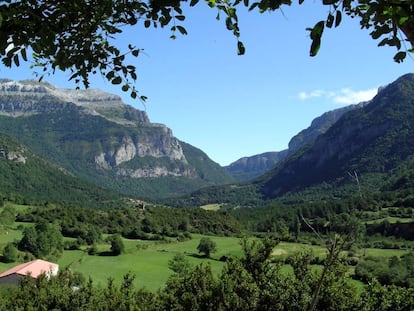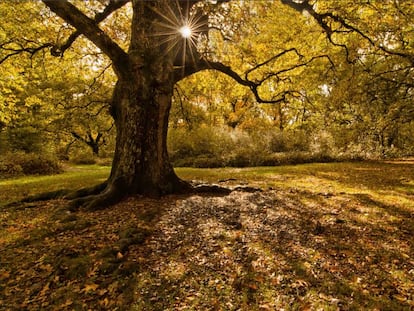Forget the parties: Four hiking trails to discover the quiet side of Ibiza
Eerily silent paths meander through pine groves and fig trees before opening up to the sea on an island that has preserved unspoiled areas despite the tourist boom
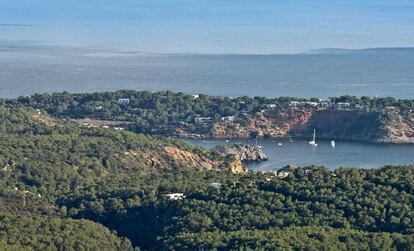
In Ibiza, the countryside smells of salt and its gentle slopes make for relaxing hikes among its fig and almond trees, its streams and valleys. This is where the philosopher Walter Benjamin went for walks in the 1930s, reporting that Ibiza was “the most virgin of the inhabitable lands I’ve seen.” A century later, this member of Spain’s Balearic Islands still has corners as yet unspoiled by ferocious urban development where hiking trails wind through dense pine forests overlooking the Mediterranean and sometimes include stops at hidden coves where an off-season dip beckons.
Es Caló de s’Illa
A rough track doesn’t seem the most likely route to unearthing Ibiza’s hidden charms. The potholed old forest trail that runs a few meters from Benirrás beach takes the hiker to an eerily silent place. The breeze blows through the tops of the pines, imitating the sound of the sea below, which will be glimpsed after a 20-minute climb through a forest that has been restored following a fire in 2010. From here, you can also see the end of the trail that takes you to the eastern tip of the island and Es Caló de s’Illa, one of its smallest and most remote coves. The path narrows and zigzags towards this destination through sandy land and a stretch of oleanders and wild carrots. One of the most solitary beaches in all of Ibiza, it’s worth the walk that is just 3.5 kilometers. If you don’t want to come back the way you came, there’s a circular route running eight kilometers in total between dreamy villas and a typical Mediterranean landscape that will bring you back to Benirrás.
Sa Talaia
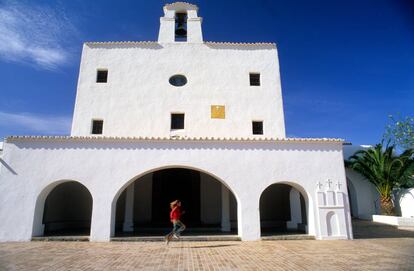
At 475 meters above sea level, Sa Talaia is the highest point in Ibiza. Up here, you get to see most of the island’s gems. Lizards scamper along the old walls and among the thyme that scents the air. There are fig trees of surprising shapes and sizes and ancient-looking olive trees. There are also small vegetable gardens and a pine forest with views of the distant Es Vedrà islet. The hike starts from a cobbled alley in the western part of Sant Josep de Sa Talaia, very close to the church that gives the village its name. The climb is steady but gentle, along paths and forest tracks that take you to the south of the summit. You can then follow the official route or take a more direct option to the top. The descent is easier and takes you past the chapel of Ses Roques Altes, built in the 1970s in honor of the 104 fatal victims of a plane crash.
Moscarter lighthouse
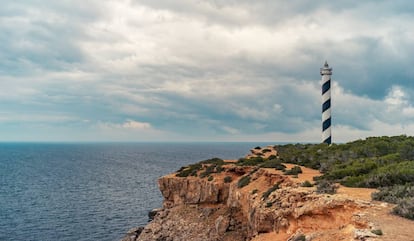
This lighthouse rises 52 meters from the ground and not only flashes every five seconds, it also dazzles visitors with its black and white spiraling bands. The highest lighthouse in the Balearic Islands, it stands on cliffs next to a forest of twisted junipers. The walk up to it is simple. It starts in the cove of Portinatx and takes you along rocky terrain by the sea, with the occasional vertiginous view to the sea below. It’s just 1.5 kilometers to the lighthouse, then the trail continues eastward to Punta des Gat and then south to the unique D’en Serra cove. There the path forks, with one trail taking you back to Portinatx (a total of six kilometers) and another one taking you down to the beach where another path joins it to take hikers on a scenic circular route, for a total of 12 kilometers. The restaurant El Puerto and the hotel Los Enamorados are two excellent spots to recharge your batteries.
Es Portitxol
At the cove of Portinatx, there are small boats that will take you to the offbeat cove of Es Portitxol, where the water is crystal clear. But you’ll appreciate it even more at the end of a hike. “This is the rural Ibiza experience – of its hardy locals who are half farmers and half fishermen,” says Miguel Ángel Álvarez in his guide All the beaches of Ibiza. “It’s the struggling and tenacious Ibiza, which managed to survive despite the pirate attacks and the challenging landscape.” To find the cove, you have to go to Sant Miquel de Balansat, head towards Sant Mateu and follow the signs to the Isla Blanca residential estate, where the road ends in a large parking lot. From there, the path is signposted and initially weaves through dense vegetation of brambles and wild blackberries, offering beautiful views of the sea and passing old lime kilns and terraced fields of fig trees. After two kilometers, you can appreciate how the cove’s small turquoise lagoon opens out to the sea. Back at the starting point, there will be time to savor the pizzas and snacks at Can Sulayetas, the kind of place that preserves the essence of an island that is best discovered on foot.
Tu suscripción se está usando en otro dispositivo
¿Quieres añadir otro usuario a tu suscripción?
Si continúas leyendo en este dispositivo, no se podrá leer en el otro.
FlechaTu suscripción se está usando en otro dispositivo y solo puedes acceder a EL PAÍS desde un dispositivo a la vez.
Si quieres compartir tu cuenta, cambia tu suscripción a la modalidad Premium, así podrás añadir otro usuario. Cada uno accederá con su propia cuenta de email, lo que os permitirá personalizar vuestra experiencia en EL PAÍS.
¿Tienes una suscripción de empresa? Accede aquí para contratar más cuentas.
En el caso de no saber quién está usando tu cuenta, te recomendamos cambiar tu contraseña aquí.
Si decides continuar compartiendo tu cuenta, este mensaje se mostrará en tu dispositivo y en el de la otra persona que está usando tu cuenta de forma indefinida, afectando a tu experiencia de lectura. Puedes consultar aquí los términos y condiciones de la suscripción digital.
More information
Últimas noticias
Most viewed
- Oona Chaplin: ‘I told James Cameron that I was living in a treehouse and starting a permaculture project with a friend’
- Sinaloa Cartel war is taking its toll on Los Chapitos
- Reinhard Genzel, Nobel laureate in physics: ‘One-minute videos will never give you the truth’
- Why the price of coffee has skyrocketed: from Brazilian plantations to specialty coffee houses
- Silver prices are going crazy: This is what’s fueling the rally

